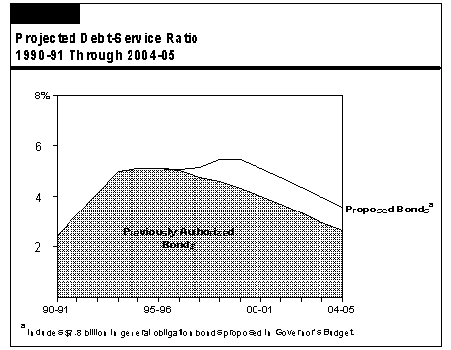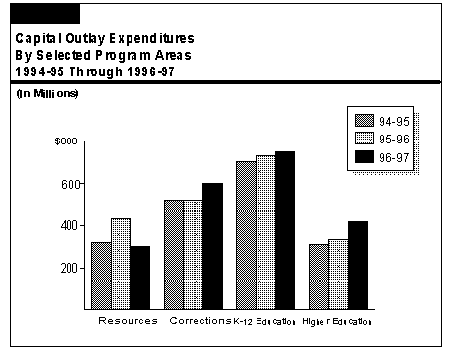Direct Appropriations.Capital costs through proposed direct appropria tions total $131 million--about $5 million less than in 1995-96. These expenditures include $81 million from the General Fund and $50 million from various special funds, such as the Motor Vehicle Account.
The amount of debt service as a percentage of state General Fund revenues (that is, the state's debt ratio) is estimated to be 5.1 percent for the current year. This ratio has risen since 1990-91 (when it was 2.5 percent), but will slowly decline in 1996-97 and beyond if no new bonds are authorized. (This projection uses our General Fund revenue estimates and does not account for any impacts of the Governor's tax cut proposals on future revenues.) Figure 2 shows the impact on the debt ratio if voters were to approve the Governor's general obligation bond proposals for the 1996 ballots (a total of $7.8 billion). We estimate that sales of these additional bonds would increase the debt ratio in future years by about 1 percent.


About $2.1 billion, or 81 percent, of capital outlay expenditures fall within four areas--K-12 education, youth and adult corrections, resources, and higher education. Figure 3 shows the expenditures in each of these areas over the past three years. The figure reflects the increased costs to make debt payments on bonds issued for these programs. The expenditures do not necessarily reflect actual construction activity because of the lag between construction, bond sales, and debt payments.



We now turn from a discussion of capital outlay expenditures (the current costs of paying for capital assets) to a summary of the 1996-97 capital outlay program (proposals to obtain capital assets). The budget includes $820 million for capital outlay programs (excluding transportation systems). This is an increase of $130 million, or 19 percent, over current-year appropriations.
The five-year plans prepared by state agencies provide a project-specific inventory of needs. Figure 4 shows a summary of these five-year plans, which total $25 billion for state agencies and for K-12 education. These five-year estimates should be viewed with caution because some of the plans are incomplete and also may include proposals that, upon examination, would not merit funding. Nevertheless, the plans provide a reasonable assessment of the overall magnitude of the agencies needs.
Figure 4
Projected Five-Year Capital Outlay Needs
For the State and K-12 Education
1996-97 Through 2000-01
(In Millions) | |
|---|
| Five-Year Total
|
|---|
| Executive | $50 |
| State and Consumer Services | 1,325 |
Department of Motor Vehicles/
California Highway Patrol | 243 |
| Resources | 840 |
| Health and Welfare | 420 |
| Youth and Adult Corrections | 4,604 |
| K-12 Education | 10,500a |
| Higher Education | 6,610 |
| General Government | 228 |
| Total | $24,820 |
|
| a Estimate only. No statewide five-year plan. |
Figure 5 (see page 10) compares each department's capital outlay funding request for 1995-96 with the amount approved by the administration for inclusion in the Governor's Budget. The budget includes about 60 percent of the $1.4 billion requested. As shown in the figure, the projects in the budget have a future completion cost of $730 million. About 50 percent of this future cost is for higher education.
Figure 5
1996-97 State Capital Outlay Summary
(In Thousands) |
|---|
| Department | Department
Requests | Governor's Budget
1996-97 Amount | Future
Cost |
|---|
| | | |
| Emergency Services | $4,227 | $4,227 | $23,939 |
| General Services | 154,569 | 154,569 | -- |
| Transportation | 2,118 | 2,118 | -- |
| Highway Patrol | 12,528 | 10,000 | 5,468 |
| Motor Vehicles | 9,954 | 9,483 | 3,240 |
| Tahoe Conservancy | 14,217 | 2,983 | -- |
| Conservation Corps | 380 | 380 | -- |
| Forestry and Fire Protection | 52,556 | 16,743 | 15,250 |
| Fish and Game | 2,373 | 505 | -- |
| Wildlife Conservation Board | 22,465 | 13,327 | -- |
| Boating and Waterways | 10,251 | 4,512 | 2,312 |
| Coastal Conservancy | 6,660 | 4,663 | -- |
| Parks and Recreation | 31,928 | 18,296 | -- |
| San Joaquin River Conservancy | 40 | 40 | -- |
| Water Resources | 11,025 | 6,400 | -- |
| Health Services | 40,080 | 2,989 | 97,159 |
| Mental Health | 29,754 | 17,972 | -- |
| Employment Development | 9,785 | 9,394 | -- |
| Corrections | 79,639 | 84,812 | 39,487 |
| Youth Authority | 34,599 | 31,248 | 147,998 |
| University of California | 152,235 | 142,325 | 53,961 |
| Hastings College of the Law | 709 | 709 | 8,291 |
| California State University | 416,350 | 150,000 | 179,899 |
| Community Colleges | 321,652 | 119,592 | 139,576 |
| Cal Expo | 2,225 | 483 | -- |
| Food and Agriculture | 2,178 | 1,036 | 4,096 |
| Military | 17,005 | 10,500 | 9,066 |
| Veterans' Home of California | 9,691 | 620 | -- |
| Unallocated capital outlay | 200 | 200 | 0 |
| Totals | $1,415,393 | $820,126 | $729,742 |
Figure 6 shows the budget proposal for each department by funding type. Almost 80 percent of all funding ($647 million) is proposed from GO bonds. About $490 million of this bond funding is dependent on legislative and/or voter approval of new bonds in 1996. The budget also includes $77 million from the General Fund for capital outlay projects. Other capital outlay funding is proposed from various special funds ($59 million) and from federal funds ($36 million). No new funding is proposed from lease-payment bonds.
Figure 6
1996-97 Capital Outlay Program
Proposed Expenditures by Fund Type
(In Thousands) |
|---|
| Department | Bonds | General | Special | Federal | Total |
|---|
| | | | | |
| Emergency Services | -- | $4,227 | -- | -- | $4,227 |
| General Services | $154,569 | -- | -- | -- | 154,569 |
| Transportation | -- | -- | $2,118 | -- | 2,118 |
| Highway Patrol | -- | -- | 10,000 | -- | 10,000 |
| Motor Vehicles | -- | -- | 9,483 | -- | 9,483 |
| Tahoe Conservancy | -- | 2,500 | 483 | -- | 2,983 |
| Conservation Corps | -- | 380 | -- | -- | 380 |
| Forestry and Fire Protection | -- | 16,743 | -- | -- | 16,743 |
| Fish and Game | -- | -- | 305 | $200 | 505 |
| Wildlife Conservation Board | 1,561 | -- | 11,766 | -- | 13,327 |
| Boating and Waterways | -- | -- | 4,512 | -- | 4,512 |
| Coastal Conservancy | -- | -- | 4,663 | -- | 4,663 |
| Parks and Recreation | 178 | 5,481 | 12,037 | 600 | 18,296 |
| San Joaquin River Conservancy | -- | -- | 40 | -- | 40 |
| Water Resources | -- | 6,400 | -- | -- | 6,400 |
| Health Services | -- | 2,989 | -- | -- | 2,989 |
| Mental Health | -- | 17,972 | -- | -- | 17,972 |
| Employment Development | -- | -- | 3,004 | 6,390 | 9,394 |
| Corrections | 50,612a | 7,200 | -- | 27,000 | 84,812 |
| Youth Authority | 27,748a | 3,500 | -- | -- | 31,248 |
| University of California | 142,325a | -- | -- | -- | 142,325 |
| Hastings College of the Law | 709a | -- | -- | -- | 709 |
| California State University | 150,000a | -- | -- | -- | 150,000 |
| Community Colleges | 119,592a | -- | -- | -- | 119,592 |
| Cal Expo | -- | -- | 483 | -- | 483 |
| Food and Agriculture | -- | 595 | 441 | -- | 1,036 |
| Military | -- | 8,470 | -- | 2,030 | 10,500 |
| Veterans' Home of California | -- | 620 | -- | -- | 620 |
| Unallocated | -- | 200 | -- | -- | 200 |
| Totals | $647,294 | $77,277 | $59,335 | $36,220 | $820,126 |
| a Dependent on legislative and/or voter approval of proposed bonds. |
The budget indicates the Governor's support for (1) the two bond measures already placed on the March 1996 ballot and (2) three additional bond measures for the November 1996 ballot. These five measures, totaling $7.8 billion, are summarized below:
March 1996 Ballot
Governor's Proposal for November 1996 Ballot
- $2.2 billion for youth and adult corrections.
--$1.642 billion for six new state prisons.
--$150 million for additional capacity at the Department of the Youth Authority.
--$274 million for existing prison and Youth Authority facilities.
-- $150 million for local juvenile detention facilities.
- $540 million for water-related facilities and programs.
--$220 million to implement a water management plan for the San Francisco Bay/Sacramento-San Joaquin Delta.
--$320 million for local wastewater treatment plants and water reclamation facilities.
- $100 million for a state infrastructure bank "dedicated to nontransportation infrastructure with an emphasis on projects that promote economic development."
The state continues to be faced with the situation we discussed last year in the Analysis of the 1995-96 Budget Bill(page I-13). The state and local governments have tens of billions of dollars in unfunded capital outlay needs. In recent years, bonds have been a primary fund source for capital outlay, but almost all GO bonds that were previously approved by the voters have been allocated to specific projects. The state's debt service costs have increased significantly since 1990, resulting in a relatively high General Fund debt service ratio of 5.1 percent. This ratio will decline, beginning in 1996-97, if no new bonds are approved and sold. We believe that the state could prudently approve and issue additional GO bonds, but in doing so it is essential that any additional bonds be directed to the state's highest priority needs.
As we discussed last year, state capital outlay programs and consideration of assistance to local governments have not been reviewed and funded in the context of a statewide program. We believe that the Legislature must undertake a comprehensive review of the state's capital outlay needs, set priorities, and establish a financing plan to fund these priorities over a multiyear period.
Return to LAO Budget Analysis Table of Contents
Return to LAO Home Page



